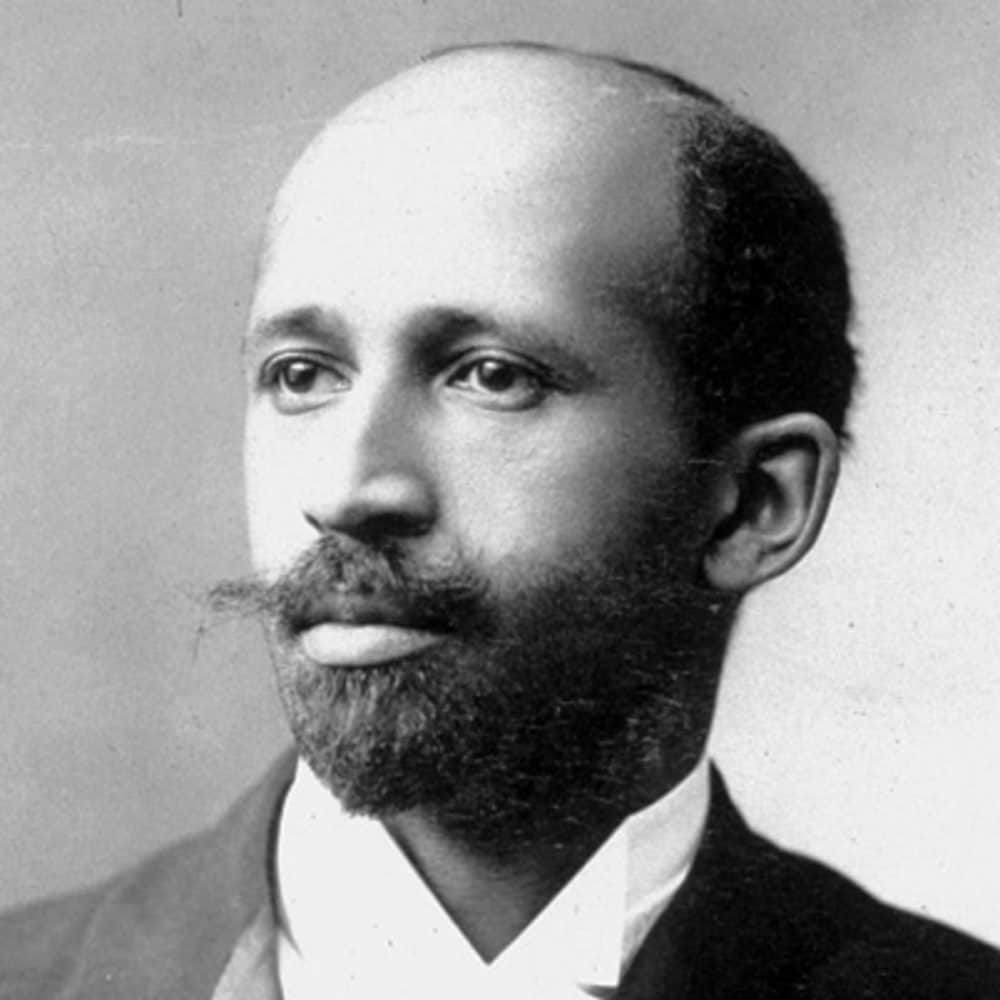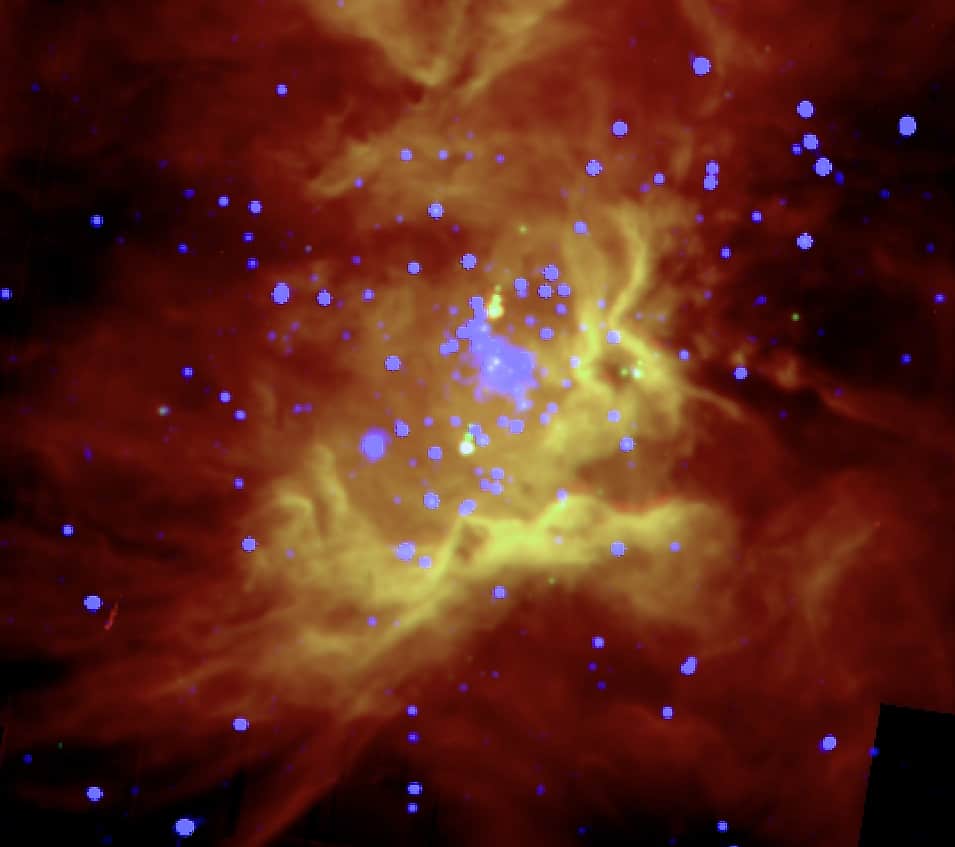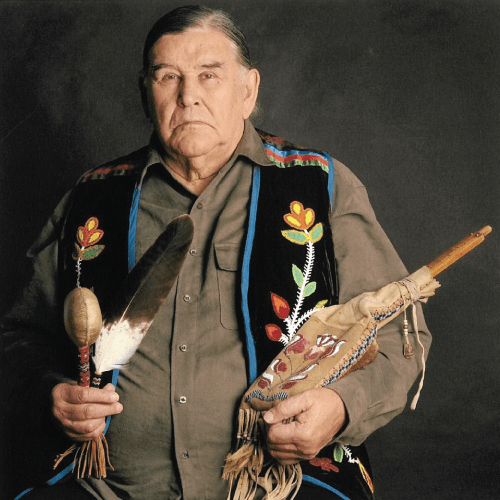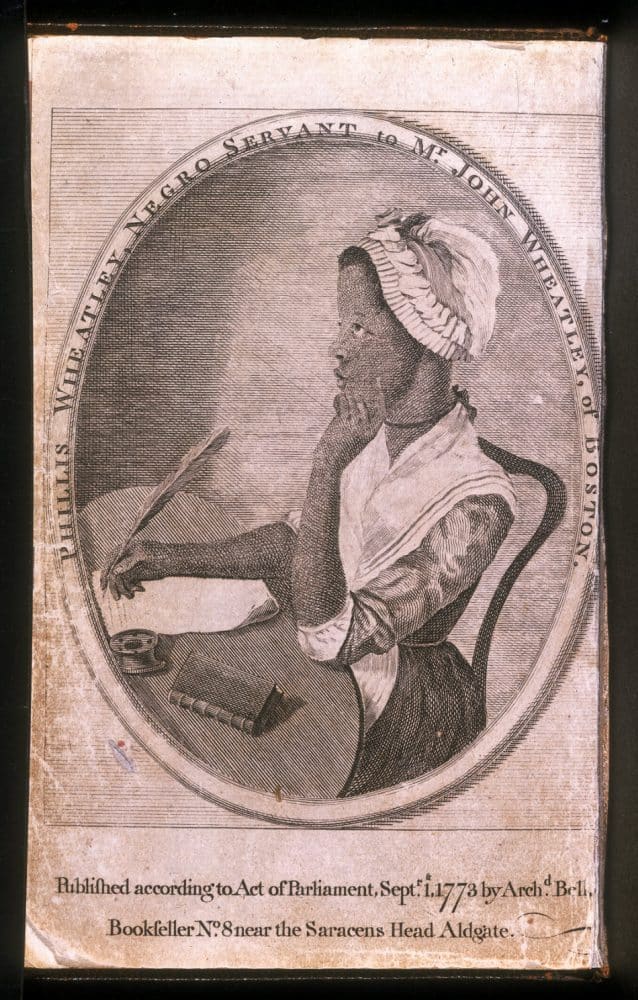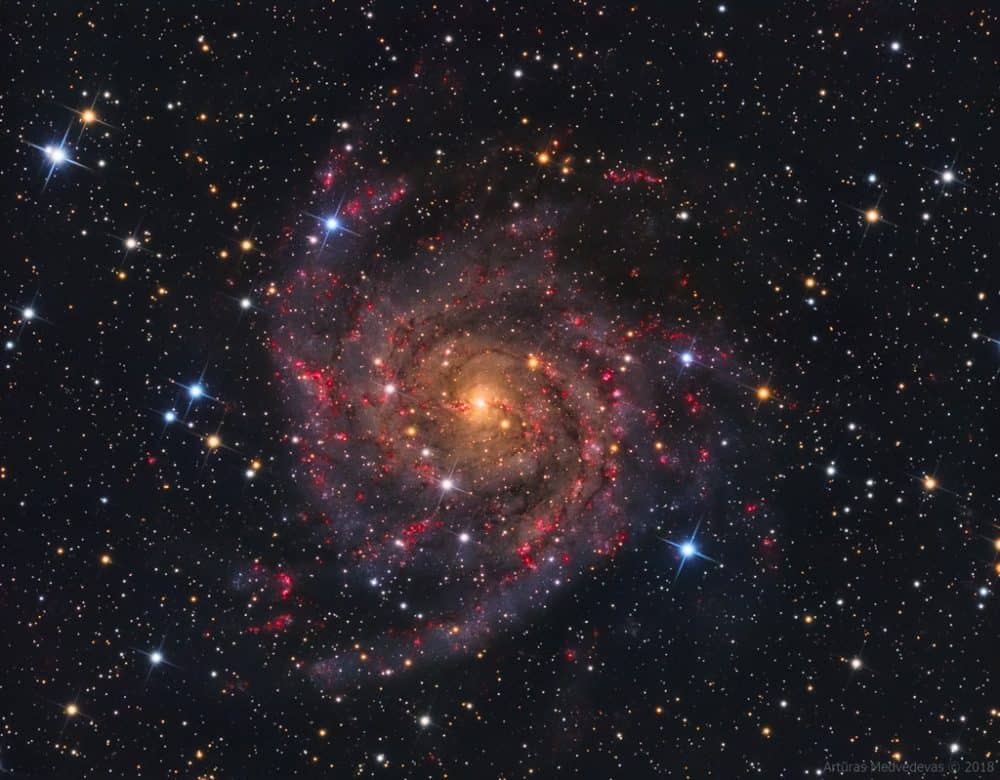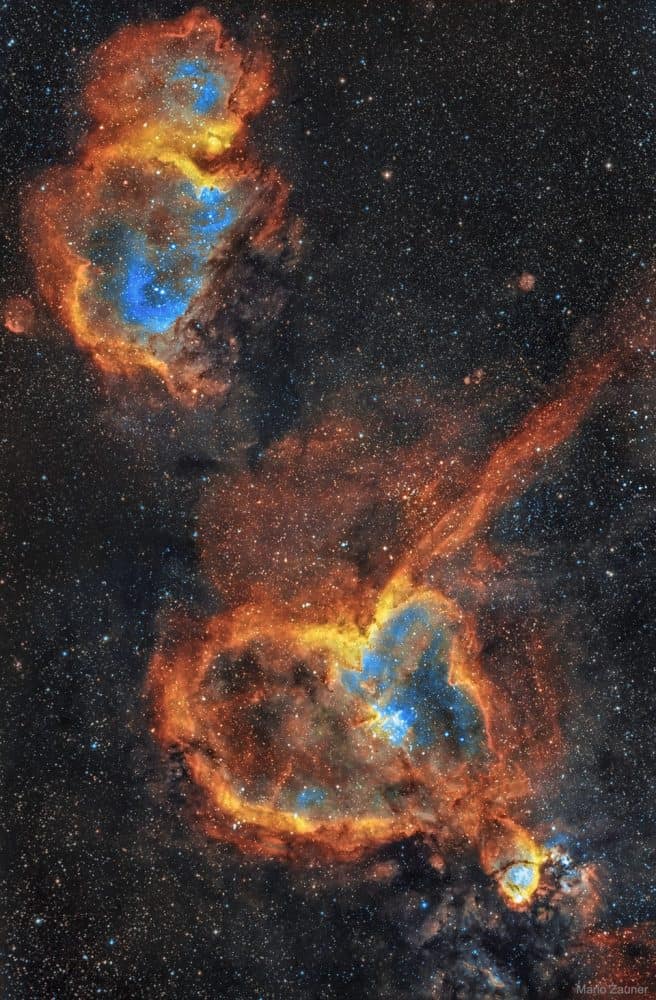Blog
RCW 36 (also designated Gum 20) is an emission nebula containing an open cluster in the constellation Vela. This H II region is part of a larger-scale star-forming complex known as the Vela Molecular Ridge (VMR), a collection of molecular clouds in the Milky Way that contain multiple sites of ongoing star-formation activity. The VMR is made up of several distinct clouds, and RCW 36 is embedded in the VMR Cloud C.
RCW 36 is one of the sites of massive-star formation closest to our Solar System, whose distance of approximately 700 parsecs (2300 light-years). The most massive stars in the star cluster are two stars with late-O or early-B spectral types, but the cluster also contains hundreds of lower-mass stars. This region is also home to objects with Herbig–Haro jets, HH 1042 and HH 1043.
more...Cyrus Chestnut (born January 17, 1963) is an American jazz pianist, composer and producer. In 2006, Josh Tyrangiel, music critic for Time, wrote: “What makes Chestnut the best jazz pianist of his generation is a willingness to abandon notes and play space.” Chestnut enjoys mixing styles and resists being typecast in any one niche, though his gospel sound is apparent on a number of his recordings.
Cyrus Chestnut was born in Baltimore, Maryland, in 1963, son of McDonald (a retired post-office employee and church pianist) and Flossie (a city social services worker and church choir director). Chestnut started learning piano at the age of seven, and in his boyhood played at Mount Calvary Baptist Church. By the age of nine, he was studying classical music at the Peabody Institute.In 1985, Chestnut earned a degree in jazz composition and arranging from Boston’s Berklee College of Music. While at Berklee, Chestnut was awarded the Eubie Blake Fellowship (1982), the Quincy Jones Scholarship (1983), and the Oscar Peterson Scholarship (1984).
Chestnut toured as pianist for Jon Hendricks, 1986–88; Terrence Blanchard, 1988–90; Donald Harrison, 1988–90; Wynton Marsalis, 1991; and the Betty Carter Trio, 1991–93. His association with Carter significantly affected his outlook and approach to music, confirming his already iconoclastic instincts. Carter advised him to “take chances” and “play things I’ve never heard,” Chestnut said.
In 1993, at the age of 30, Chestnut signed with Atlantic Records, releasing the critically acclaimed Revelation (1993), followed by The Dark Before The Dawn (1994) (the album debuted in the sixth spot on the Billboard Jazz Charts), Earth Stories (1995) and then Cyrus Chestnut (1998). Chestnut has also performed and/or recorded with, Freddy Cole, Bette Midler, Jon Hendricks, Freddie Hubbard, Jimmy Scott, Chick Corea, Isaac Hayes, Kevin Mahogany, Dizzy Gillespie, and opera diva Kathleen Battle, most notably on the Sony Classical recording “So Many Stars”. Their shared church roots resulted in such a positive chemistry between Battle and Chestnut that he then joined the soprano on a fall 1996 U.S. Tour.
more...Billy Harper (born January 17, 1943) is an American jazz saxophonist, “one of a generation of Coltrane-influenced tenor saxophonists” with a distinctively stern, hard-as-nails sound on his instrument.
Harper has played with some of jazz’s greatest drummers; he served with Art Blakey‘s Messengers for two years (1968–70); he played very briefly with Elvin Jones (1970), he played with the Thad Jones/ Mel Lewis Orchestra in the 1970s, and was a member of Max Roach‘s band in the late 1970s. In 1979 Harper formed his own group, touring with it and documenting its music on the recording, “Billy Harper Quintet in Europe“, and he was featured as a soloist on a 1983 recording, “Such Good Friends,” with virtuoso, visionary pianist and record producer Stanley Cowell. After a period of relative inactivity in the 1980s, Harper came back strong with another international tour, which ended with perhaps his most ambitious recording: the 3-volume “Live on Tour in the Far East” (1991). In the new millennium Harper’s recording activity has been subdued and sporadic, though recently he has appeared as a regular member of pianist-jazz historian Randy Weston‘s ensembles. In 2013 they recorded their first album as a duo, entitled The Roots of the Blues.
https://www.youtube.com/watch?v=jBFqymr-NoM
more...Cedar Anthony Walton, Jr. (January 17, 1934 – August 19, 2013) was an American hard bop jazz pianist. He came to prominence as a member of drummer Art Blakey‘s band before establishing a long career as a bandleader and composer. Several of his compositions have become jazz standards, including “Mosaic”, “Bolivia”, “Holy Land”, “Mode for Joe” and “Fantasy in D”.
Walton was born and grew up in Dallas, Texas. His mother Ruth was an aspiring concert pianist, and was Walton’s initial teacher.She also took him to jazz performances around Dallas. Walton cited Nat King Cole, Bud Powell, Thelonious Monk and Art Tatum as his major influences on piano. He began emulating recordings of these artists from an early age.
After briefly attending Dillard University in New Orleans, he went to the University of Denver as a composition major originally, but was encouraged to switch to a music education program targeted to set up a career in the local public school system. This switch later proved extremely useful since Walton learned to play and arrange for various instruments, a talent he would hone with Art Blakey’s Jazz Messengers.
Walton was tempted by the promise of New York City through his associations with John Coltrane, Charlie Parker, and Richie Powell, whom he met at various after-hours sessions around the city of Denver, Colorado. In 1955, he decided to leave school and drove with a friend to New York City. He quickly got recognition from Johnny Garry, who ran Birdland at that time.
Walton was drafted into the U.S. Army, and stationed in Germany, cutting short his rising status in the after-hours scene. While in the Army, he played with musicians Leo Wright, Don Ellis, and Eddie Harris. Upon his discharge after two years, Walton picked up where he left off, playing as a sideman with Kenny Dorham (on whose 1958 album This Is the Moment! Walton made his recording debut), J. J. Johnson, and with Gigi Gryce.[6] Joining the Jazztet, led by Benny Golson and Art Farmer, Walton played with this group from 1958 to 1961. In April 1959, he recorded an alternate take of “Giant Steps” with John Coltrane, though he did not solo.
more...Tuareg songwriter and musician based in Agadez, Niger
more...“In every human Breast, God has implanted a Principle, which we call Love of Freedom; it is impatient of Oppression, and pants for Deliverance.”
more...Similar in size to large, bright spiral galaxies in our neighborhood, IC 342 is a mere 10 million light-years distant in the long-necked, northern constellation Camelopardalis. A sprawling island universe, IC 342 would otherwise be a prominent galaxy in our night sky, but it is hidden from clear view and only glimpsed through the veil of stars, gas and dust clouds along the plane of our own Milky Way galaxy. Even though IC 342’s light is dimmed and reddened by intervening cosmic clouds, this sharp telescopic image traces the galaxy’s own obscuring dust, young star clusters, and glowing pink star forming regions along spiral arms that wind far from the galaxy’s core. IC 342 may have undergone a recent burst of star formation activity and is close enough to have gravitationally influenced the evolution of the local group of galaxies and the Milky Way.
more...Helen Folasade Adu, CBE (Yoruba: Fọláṣadé Adú [fɔ̄láʃādé ādú]; born 16 January 1959), known professionally as Sade Adu or simply Sade (/ʃɑːˈdeɪ/ shah-DAY), is a British Nigerian singer, songwriter, and actress.
Born in Ibadan, Nigeria and brought up in Essex, England, Sade gained modest recognition as a fashion designer and part-time model, prior to joining the band Pride in the early 1980s. After gaining attention as a performer, she formed the band Sade, and secured a recording contract with Epic Records in 1983. The band then released the album Diamond Life a year later, which became one of the best selling albums of the era, and the best-selling debut ever by a British female vocalist. It also gained widespread critical acclaim and is largely considered one of the best albums of all-time.
Soon after, they released Promise (1985), which was also a resounding critical and commercial success, topping the UK Albums Chart and becoming the band’s first album to debut atop the Billboard 200. It later earned quadruple platinum certification in the U.S., and reached platinum across Europe. It also earned the group the Grammy Award for Best New Artist in 1986. Their following two releases, 1988’s Stronger Than Pride and 1992’s Love Deluxe, were also critically and commercially successful; however, the band would go on hiatus after the birth of Sade’s child, the singer would experience widespread media coverage during the period for unsubstantiated claims of mental health and addiction issues.
After a spell of eight years without an album, which came after Sade appeared in the film Absolute Beginners (1986), the band reunited in 1999, and released Lovers Rock in 2000. The album departed from the jazz-inspired inflections of their previous work, featuring more mellow sounds and pop compositions, and was critically praised, earning the group the Grammy Award for Best Pop Vocal Album. The band would then undergo another term of hiatus, not producing music for another ten years until the release of Soldier of Love. The album was another commercial success, although critical reception remained divided, but won the group the Grammy Award for Best R&B Performance by a Duo or Group with Vocals. Following the album’s release, the band entered a third period of hiatus, and have only released one new song (2018’s “Flower of the Universe” for the soundtrack of Disney’s A Wrinkle in Time) to date.
Sade is widely considered a musical influence, and her contributions to music have made her a global figure in popular culture for over two decades. She has been credited as one of the most successful British female artists in history, and her work is listed among the finest in modern jazz history. Her services to music were also commemorated after being awarded the Officer of the Order of the British Empire chivalry honour in 2002.
more...Aldo Romano (born 16 January 1941 in Belluno, Italy) is a jazz drummer. He also founded a rock group in 1971.
Lester “Mad Dog” Davenport (January 16, 1932 – March 17, 2009), was an American Chicago blues harmonica player and singer.
Born in Tchula, Mississippi, Davenport moved to Chicago, Illinois, when he was 14. There he played with Arthur Spires, Snooky Pryor, and Homesick James and then worked with Bo Diddley, with whom he played harmonica on a 1955 Chess Records session. He led his own group in the 1960s while working during the day as a paint sprayer. In the 1980s he was the harmonica player for the Indiana group the Kinsey Report.
In July 1994, Wolf Records released the album Chicago Blues Session, Vol. 11, by Maxwell Street Jimmy Davis, recorded in 1988 and 1989. The collection included Davenport on harmonica and Kansas City Red playing the drums.
Davenport released his first album under his own name in 1992 and recorded a follow-up, I Smell a Rat, in 2002.
Davenport died in March 2009 in Chicago, from prostate cancer, at the age of 77.
more...Anxo Lorenzo has managed to fuse the unadulterated natural sound of the gaita (Galician bagpipes) with a wide variety of alternative music styles
more...The Heart Nebula, officially dubbed IC 1805and visible in the featured image on the bottom right, has a shape reminiscent of a classical heart symbol. The Soul Nebula is officially designated IC 1871 and is visible on the upper left. Both nebulas shine brightly in the red light of energized hydrogen. Also shown in this three-color montage is light emitted from sulfur, shown in yellow, and oxygen, shown in blue. Several young open clusters of stars are visible near the nebula centers. Light takes about 6,000 years to reach us from these nebulas, which together span roughly 300 light years. Studies of stars and clusters like those found in the Heart and Soul Nebulas have focused on how massive starsform and how they affect their environment.
more...Don Van Vliet (/væn
Van Vliet developed an eclectic musical taste during his teen years in Lancaster, California, and formed “a mutually useful but volatile” friendship with Zappa. He began performing with his Captain Beefheart persona in 1964 and joined the original Magic Band line-up, initiated by Alexis Snouffer, the same year. The group released their debut album Safe as Milk in 1967 on Buddah Records. After being dropped by two consecutive record labels they signed to Zappa’s Straight Records, where they released 1969’s Trout Mask Replica; an album variously described as “unlistenable”, “a joke”, and a “masterpiece”, that would later rank 58th in Rolling Stone magazine’s 2003 list of the 500 greatest albums of all time. In 1974, frustrated by lack of commercial success, he pursued a more conventional rock sound, but the ensuing albums were critically panned; this move, combined with not having been paid for a European tour, and years of enduring Beefheart’s abusive behavior, led the entire band to quit. Beefheart eventually formed a new Magic Band with a group of younger musicians and regained critical approval through three final albums: Shiny Beast (1978), Doc at the Radar Station (1980) and Ice Cream for Crow (1982).
Widely regarded as unusual and interesting, critics have had difficulty in pinning down Beefheart’s musical style; he has been described as “one of modern music’s true innovators”, though most see his music as a quirky and idiosyncratic variation of blues music which, while not achieving mainstream commercial success, attracted a cult following and was an influence on new wave, punk, and experimental rock artists.
more...Earl Zebedee Hooker (January 15, 1930 – April 21, 1970) was a Chicago blues guitarist known for his slide guitar playing. Considered a “musician’s musician”, he performed with blues artists such as Sonny Boy Williamson II, Junior Wells, and John Lee Hooker and fronted his own bands. An early player of the electric guitar, Hooker was influenced by the modern urban styles of T-Bone Walker and Robert Nighthawk. He recorded several singles and albums as a bandleader and with other well-known artists. His “Blue Guitar”, a slide guitar instrumental single, was popular in the Chicago area and was later overdubbed with vocals by Muddy Waters as “You Shook Me“.
In the late 1960s, Hooker began performing on the college and concert circuit and had several recording contracts. Just as his career was on an upswing, he died in 1970, at age 40, after a lifelong struggle with tuberculosis. His guitar playing has been acknowledged by many of his peers, including B.B. King, who commented, “to me he is the best of modern guitarists. Period. With the slide he was the best. It was nobody else like him, he was just one of a kind”.
More Posts
- Howard Wyeth
- Paul Chambers
- Joe Cuba
- Charles Mingus
- Flamenco Fridays Paco de Lucia
- Daily Roots Admiral Tibet
- Happy National High Five Day 2022
- Cosmos NGC 1566
- Iggy Pop
- Pee Wee Ellis
- Slide Hampton
- Mundell Lowe
- STOP THE WAR IN UKRAINE Joryj Kłoc
- Daily Roots Mike Anthony
- Cosmos M104
- Joe Bonner
- Tito Puente
- Lionel Hampton
- FREE UKRAINE Burdon
- Daily Roots Jimmy Cliff
